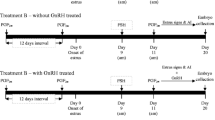Abstract
Purpose
To study the effects of r-hLH as ovulatory stimulus in does.
Method
New Zealand does, 18 kw old, in estrus, received 25 IU of pregnant mare serum gonadotropin (PMSG) followed at 48 h either by 50 IU of r-hLH (n=20) or hCG (n=20) to induce follicular growth and ovulation. All does were previously artificially inseminated to avoid endogenous LH surge. Half of the animals receiving r-hLH (n=10) or hCG (n=10) were killed at 72 h after the hormone administration, and the remaining half were killed at 14 days. At 72 h the number of corpora lutea and preovulatory folliclés was determined, and fertilization rate, embryo quality, degree of embryonic development, and oviductal transit were all assessed. On Day 14 the number corpora lutea and implanted embryos were counted, and implantation rate was determined. Median and interquartile ranges were calculated for each parameter.
Results
At 72 h the median for corpora lutea was 8 (7–10) in the r-hLH group vs 13 (10–14) in the hCG group (P=0.009); preopvulatory follicles were 7 (6–10) vs 0 (0-0) (P=0.0007); the percentage of good-quality embryos was 71.4% (54.5–75) vs 33.3% (25–37.5) (P=0.001), for intermediate-quality embryos it was 25% (14.3–36.4) vs 33.3% (25–38.5), and the percentage of degenerated embryos was 0% (0–12.5) vs 33.3% (25–37.5) (P=0.015), respectively. Fertilization rates were similar in both groups. Embryonic development was more homogeneous in the animals receiving r-hLH (8 to ≥ 16 cells) compared to those receiving hCG (2 to ≥ 16 cells). The median of embryos still in oviducts at 72 h was significantly higher in the hCG group [6 (4–13)] than in the r-hLH group [0 (0–4)] (P=0.41). At 14 days the median of corpora lutea was higher in the hCG [12 (11–16)] than in the r-hLH group [10(7–13)] (P=0.008), but no differences were noted in the number of implanted embryos. Implantation rate was higher in the r-hLH group [100 (92.3–100)] than in the hCG group [87.5 (83.3–94.1)] (P=0.056).
Conclusions
At the studied dose an ovulatory stimulus with r-hLH induced fewer follicles to ovulate than hCG. Recombinant-hLH produced superior embryo morphological quality, a more homogeneous degree of embryo development, and more synchronous embryo transit than hCG. In spite of the larger number of ovulations following hCG, subsequent events essential for pregnancy were higher with r-hLH, offsetting differences in terms of implanted embryos at 14 days of pregnancy.
Similar content being viewed by others
References
Fujimoto S, Rawson MR, Dukelow WR: Hormonal influences on the time of ovulation in the rabbit as determined by laparoscopy. J Reprod Fertil 1974;38:97–103
Yen SSC, Llerena O, Little B, Pearson OH:Disappearance rates of endogenous LH and hCG in man. J Clin Endocrinol Metab 1968;28:1763–1767
Niswender GD, Roess DA, Barisas BG: Receptor mediated differences in the actions of ovine luteinizing hormone vs human chorionic gonadotropin.In RL Stouffer The Primate Ovary, (ed). New York, Plenum Press, 1987, pp 237–248
Fisher RA, Nakajima ST, Gibson M, Brumsted JR: Ovulation after intravenous and intramuscular human chorionic gonadotropin. Fertil Steril 1993;60:418–422
Abbasi R, Keningsberg D, Danforth D, Falk RJ, Hodgen GD: Cumulative ovulation rate in human menopausal/human chorionic gonadotropin-treated monkeys: “step up” versus “step down” dose regimens. Fertil Steril 1987;47:1019–1024
Chandrasekher YA, Hutchison JS, Zelinski-Wooten MB, Hess DL, Wolf DP, Stouffer RL: Initiation of periovulatory events in primate follicles using recombinant and native human luteinizing hormone to mimic the midcycle gonadotropin surge. J Clin Endocrinol Metab 1994;79:298–306
Simon JA, Danforth DR, Hutchison JS, Hodgen GD: Characterization of recombinant DNA derived-human LH in vitro and in vivo. Efficacy in ovulation induction and corpus luteum support. JAMA 1988;259:3290–3295
Molina I, Pla M, Vicente JS, Martin A, Romeu A: Induction of ovulation in rabbits with pure urinary luteinizing hormone and human chorionic gonadotrophin: comparison of oocyte and embryo quality. Hum Reprod 1991;6:1449–1452.
Veeck LL, Malony M: Insemination and fertilization.In In Vitro Fertilization, Jones, Hodgen, Rosemwaks (eds). Baltimore, William & Wilkins;1986, 168–200.
Bomsell-Helmreich O, Huyen LVN, Durand-Gasselin J: Effects of varying doses of hCG on the evolution of preovulatory rabbit follicles and oocytes. Hum Reprod 1989;4:636–642.
Bordage RJ, Halbert SA: Distribution of embryos and 500 μM microspheres in the rabbit oviduct: controls for acute motion analysis during transport. Biol Reprod 1988;38:282–291
Molina I, Santana AG, Pla M, Romeu A: Induction of ovulation in rabbits with pure urinary luteinizing hormone. Comparison with human chorionic gonadotropin. Hum Reprod 1994;9:413–416
Zelinski-Wooten MB, Hutchison YA, Chandrasekher DPW, Stouffer RL: Administration of human luteinizing hormone (hLH) to macaques after follicular development: further titration of LH surge requirements for ovulatory changes in primate follicles. J Clin Endocrinol Metab 1992;75:502–507
Veeck LL: Evaluación de ovocitos y preembriones en el laboratorio FIV.In Avances en reproduccióm asistida, Remohí, Pellicer, Bonilla Musoles (eds). Madrid, Editorial Diaz de Santos, 1992; pp 117–161
Van Hell H, Matthijsen R, Overbeej GA: Effects of human menopausal gonadotropin praparations in different bioassay methods. Acta Endocrinol 1984;47:409–418
Hutchison J: Personal communication, 1994
Author information
Authors and Affiliations
Rights and permissions
About this article
Cite this article
Peinado, J.A., Molina, I., Pla, M. et al. Recombinant-human luteinizing hormone (r-hLH) as ovulatory stimulus in superovulated does. J Assist Reprod Genet 12, 61–64 (1995). https://doi.org/10.1007/BF02214131
Received:
Accepted:
Issue Date:
DOI: https://doi.org/10.1007/BF02214131




